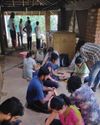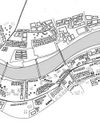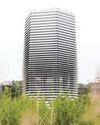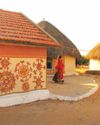Chaukor Studio has designed a house that goes back to traditional practices for addressing the challenges of the local climate and context.

Architect’s Note: The house is designed through a holistic design process; architectural design of a building is a physical manifestation of the social, cultural, political and geographical patterns of that region. The Minaret house not only embodies the climatic principles but also the social patterns that the architectural heritage offered.
In the world of today for many people it is hard to imagine living without a holistic dependence on air conditioners and heating systems, especially in areas such as the National Capital Region of India that experiences very hot summers and equally extreme winters. However, with our all embracing or perhaps dependent attitude towards today’s technology, our usage of traditional ideologies had taken a backseat. It was possible to live without air conditioners in an earlier age; were the temperatures considerably lower; were our bodies accustomed and adapted to the heat intake; or were we just more intelligent in our methods of dealing with the situation? There still are thinkers and professionals who wish to take the load that we put on our natural resources off by going back to those traditional ideologies that achieved the desired affects.
Esta historia es de la edición July 2017 de Indian Architect & Builder.
Comience su prueba gratuita de Magzter GOLD de 7 días para acceder a miles de historias premium seleccionadas y a más de 9,000 revistas y periódicos.
Ya eres suscriptor ? Conectar
Esta historia es de la edición July 2017 de Indian Architect & Builder.
Comience su prueba gratuita de Magzter GOLD de 7 días para acceder a miles de historias premium seleccionadas y a más de 9,000 revistas y periódicos.
Ya eres suscriptor? Conectar

Interlacing Perspectives
‘Meraki-2019’ A visionary Seminar series presented by Dr.Baliram Hiray College of Architecture, Bandra(East), Mumbai.

Facilitating A Community Through Architectural Practice
The humble, self-designed, self-built and organically planned home built by the majority of the world population rarely gets appreciated and critiqued as a viable lesson in architectural design.

The Art Of Solving Problems Creatively
The practice of architecture is perhaps incomplete without the complement of a variety of other arts.

Upcycling towards a playful tomorrow
Play is like the middle child, often forgotten, and always taking a back seat. For young kids, play can simply be running around, armwrestling with friends, building sandcastles on the beach, or singing popular music tracks in the shower.

Balancing The Poetics And Pragmatism Of Everyday Design
Humanity is faced with an oxymoronic crisis. The crisis involves the earth, the environment, impending looms of climate change, deforestation, loss of species, dwindling resources etc.

Just Give Me Some Space: Discussions And Beyond
Just Give Me Some Space (JGMSS) is Suha Riyaz Khopatkar’s debut book that paints a portrait of the dynamic life of an architecture student.

The Next In Vernacular Architecture
Architecture has become a capitalist.

Rethinking The Future: Architecture And Its Education
“I want to be like animals, the bird makes a nest in one or two days, the rat digs a hole in a night, but intelligent humans like us spend 30 years to have a house, that’s wrong.” - Jon Jandai

Uniting The Human-Scale With The City-Scale
London-based architect Usman Haque is famed for his interactive architectural systems, and for his exploration of newer, more effective ways of creating human engagement and interaction through his designs. Indian Architect & Builder caught up with him, to quiz him on a variety of topics such as his journey as an architect, his inspirations and philosophies, architects using the digital revolution to their advantage, and more!

Framing spaces
Almost every architect also doubles as a photographer or at least an enthusiast.